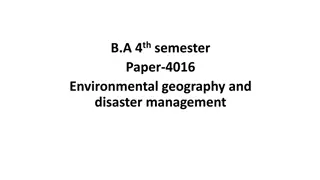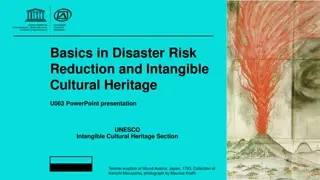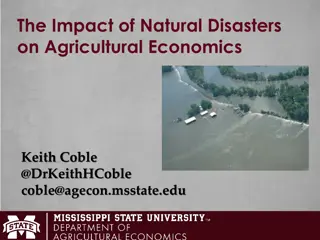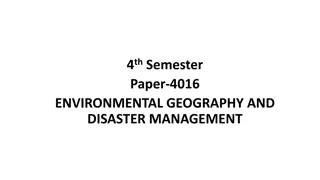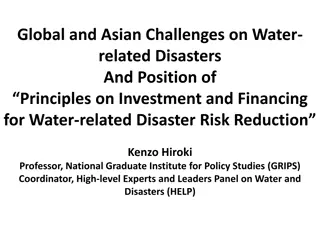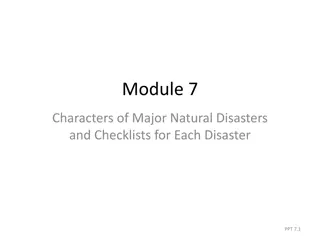Man-made Disasters: Short-term Events and Long-term Consequences
Man-made disasters come in two main forms: short-term events like oil spills or nuclear accidents, and long-term consequences such as climate change and loss of biodiversity. This article covers incidents like the Westgate Bridge Catastrophe in Melbourne and the Tasman Bridge Collapse in Hobart, highlighting the devastating impact of human error and negligence. Additionally, it explores aviation disasters, including the tragic events of September 11, 2001. These disasters serve as stark reminders of the importance of responsible practices in various industries and sectors.
Download Presentation

Please find below an Image/Link to download the presentation.
The content on the website is provided AS IS for your information and personal use only. It may not be sold, licensed, or shared on other websites without obtaining consent from the author.If you encounter any issues during the download, it is possible that the publisher has removed the file from their server.
You are allowed to download the files provided on this website for personal or commercial use, subject to the condition that they are used lawfully. All files are the property of their respective owners.
The content on the website is provided AS IS for your information and personal use only. It may not be sold, licensed, or shared on other websites without obtaining consent from the author.
E N D
Presentation Transcript
We are responsible for 2 main sorts of disasters. The first are short-term events that happen suddenly. This kind of disaster might be on the television news: a terrible oil spill or a leak from a chemical factory or a nuclear accident. The second sort of man-made disaster takes place over a long period of time. These are less likely to appear on the news because they don t happen as a single event like an oil spill. In some ways these long-term disasters are more serious. They take a long time to sort out because they build up over a long time. Examples of this include the effect our industries are having on the world s climate, loss of some of the world s species of animals and the destruction of the world s forests.
The Westgate Bridge Catastrophe Melbourne, 15thOctober 1970 The building of the Westgate Bridge was welcomed by the people of Melbourne because it would connect the city s eastern and western suburbs. Instead it turned out to be a nightmare. Thirty-five workmen were killed when a span of the bridge collapsed during construction.
Westgate Bridge Catastrophe The pinging noise was heard, followed by the screech of metal grinding over metal. The gap widened and one end of the span collapsed. The other span slid down, its 2000-tonne weight plummeting into the river.
The Tasman Bridge Collapse Hobart, 5thJanuary 1975 On a dark, drizzly night early in 1975 a 7000 tonne ship carrying a large cargo of ore tried to pass under Hobart s Tasman Bridge, but didn t make it through. Not only did the bridge collapse but the Lake Illawarra sank like a stone, claiming 12 lives.
Tasman Bridge Collapse A 73-metre long section of the bridge s roadway fell onto the Lake Illawarra . On the bridge, cars skidded as lights went out. Four cars plunged 50 metres into the Derwent River. Two others stopped, half hanging over the edge of the bridge.
Since the birth of planes, aircraft have crashed, often with serious consequences. This is because of the unforgiving nature of flight. Approximately 80 percent of all aviation accidents occur shortly before, after, or during takeoff or landing, and are often described as resulting from 'human error'; mid-flight disasters are rare but not entirely unheard of. Among other things, the latter have been caused by bombs. The deadliest aviation-related disaster of any kind, considering fatalities on both the aircraft and the ground, was the destruction of the World Trade Center in New York City on September 11, 2001 with the intentional crashing of American Airlines Flight 11 and United Airlines Flight 175. The crashes killed 2,988, most of them occupants of the World Trade Center towers or emergency personnel responding to the disaster.
September 11 Attacks Images of this terrifying day were broadcast worldwide. Onlookers watched in horror as the Twin Towers collapsed from the impact of the collision.
The March 27, 1977 Tenerife disaster This disaster remains the accident with the highest number of airliner passenger fatalities. In this disaster, 583 people died when a KLM Boeing 747 attempted take-off and collided with a taxiing Pan Am 747 at Los Rodeos Airport. Pilot error, communications problems, fog, and airfield congestion due to a bombing and a second bomb threat at another airport, which diverted air traffic to Los Rodeos, all contributed to this catastrophe.
Tenerife Disaster This disaster remains the accident with the highest number of airline passenger fatalities.
The Beaconsfield Mine collapse occurred on 25 April 2006 in Beaconsfield, Tasmania, Australia. Of the 17 people who were in the mine at the time, 14 escaped immediately following the collapse, one was killed, and the remaining two were found alive after five days, using a remote controlled device. These two miners were rescued on Tuesday 9 May, a full two weeks after being trapped nearly a kilometre below the surface.
Beaconsfield Mine Collapse At 9:26 pm (Australian Eastern Standard Time) on 21stApril 2006 a seismic event triggered an underground rock fall at the Beaconsfield gold mine in northern Tasmania.
A report from the Australian Institute of Criminology has found that half of all bushfires are deliberately lit. The report says that the damage bill from arson is about $1.6 billion per year. Most deliberate bushfires occur within or near the most densely populated regions of Australia. Consequently, the majority of deliberate fires occur along the coastal fringe, where climatic conditions are generally milder, and the period of adverse bushfire weather is shorter. Although they have the potential to burn out of control and cause immense damage, overall, the majority of deliberately lit fires are small in area (less than one to two hectares). Analysis of a number of different data sources indicates that the highest rates of recorded deliberately lit fires during adverse bushfire weather occur in areas, regions or jurisdictions with highest rates of recorded deliberate fires generally.
Black Saturday Bushfires The bushfires in Victoria have claimed more than a thousand homes and we have a death toll nearing 200 with more expected as authorities enter ruined towns. With fires already burning, conditions on Saturday made it worse. Black Saturday, Saturday the 7^th of February was the hottest day on record, the temperature reached 46.4 degrees Celsius meaning many residents didn t stand a chance due to extreme hear and strong winds. Hundreds of fires burn out of control, leaving only destruction, emergency services where stretched to the limit.
The Southern Aurora Crash Violet Town, 7thFebruary 1969 Nine people died and 36 people were injured when the Southern Aurora , travelling from Sydney to Melbourne, collided with a goods train near Violet Town in Victoria at 7.10 am on 7thFebruary 1969. The driver of the train was declared negligent because he had continued to drive trains while suffering from a heart problem.
The Southern Aurora Crash An inquest found three crew of the Southern Aurora were responsible for the crash and deaths of 9 people. The driver was declared negligent because he had a heart condition yet continued to drive trains. The fireman was also to blame because he left the control cabin to fill a kettle when he should have been looking out for signals at the loop. The guard was also guilty because he had fallen asleep and so was not able to apply the emergency brake.
Water is one of our most important natural resources and is essential for life. Despite this, for thousands of years people have used waterways as dumping grounds for waste. This has caused great damage to marine plants and animals, and increased the health risk to humans and animals who live near or drink the water. Evidently we are leaking some oil. This message came from the captain of the giant supertanker Exxon Valdez . His 200,000-tonne ship had run aground only hours after taking on a full load at the oil terminal in Alaska, USA. It was Good Friday, 24thMarch 1989. By Easter Monday, 10 million gallons of crude oil had spilled into the sea. It was one of the worst environmental disasters in history.
Oil spills An oil tanker runs aground, spilling part of its cargo into the sea. Disasters like this have a terrible short-term effect on sea life and birds.
Smog Smog is a blend of smoke and fog, a choking mixture of man-made pollution and natural mist, which settles over cities with potentially fatal results. In London, then the world s largest city, the Great Smog of 1952 killed 4000 people in four days and twice that number died later from its effects. After years of ignoring the problem, the government was forced to introduce tough clean-air laws.
Pollution in China Every day huge amounts of pollution pour into our atmosphere, storing up trouble for future generations.
The Loch Ard Shipwreck, Port Campbell, 1stJune 1878 The Loch Ardwas a ship that was wrecked off the western coast of Victoria, near Port Campbell, in 1878. Only two of the 51 passengers survived. The ship lifted high and crashed down on it s starboard (right) side onto the rocks of Mutton Bird Island. 49 people drowned. The only two to reach the shore alive were two teenagers, Eva Carmichael and Tom Pearce.
Titanic It should never have happened. On the night of 14thApril 1912, the 46,000 tonne ship Titanic smashed into the iceberg, buckling the plates of her hull so that the water poured in. In under 3 hours she was gone, and than 1,500 people with her.
Today, famine continues to stalk many countries, especially in Africa, where food shortages due to crop failure can turn into disaster because of war or corruption.
Famine in Ireland It was a national tragedy in Ireland. By the 1840s, half the people depended on just one food the potato. It gave them most of the nutrition they needed. Then without warning, a new disease infected the potato plants, wiping out the harvest for years. In the famine that followed, a million Irish people died of starvation and sickness.



